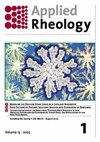Structure of pumpkin pectin and its effect on its technological properties
IF 1.8
4区 工程技术
Q1 MECHANICS
引用次数: 19
Abstract
Abstract The aim of this work is to investigate the structural features, physicochemical, rheological, and emulsifying properties of pectin extracted from pumpkin “Cucurbita maxima” pulp and peel. After the peel and pulp of fresh pumpkin were solubilized in water at high temperature (80°C) and clarification, the obtained filtrate was treated with aluminum sulphate, which precipitates a fibrous coagulum. The results found that the major functional groups of pectin isolates identified by Fourier transform infrared are: –OH, CH2, C═C, –C–O–C–, and CH3. The results obtained using nuclear magnetic resonance methods suggest that these polysaccharides consist of two domains: the first one is homogalacturonan and the second is formed by rhamnogalacturonan. Mineral and metal ions on pectin surface detected using scanning electron microscopy coupled to energy dispersive X-ray analysis were different pulp and peel pectin. Rheological behavior of these biopolymers is suitably represented by the Herschel–Bulkley and power law models. The extracted pectin has a viscosity spectrum expressed by the following properties: G′, G′′, G*, and ∣ η ̇ ∣ ( ω ) | \dot{\eta }| (\omega ) which, respectively, have the following values: 0.28–57.63, 0.15–34.38, 0.39–67.12, and 1.82–831.08 Pa s. These macromolecules have a negative charge on their surface. Rheological properties and emulsifying activity are significantly influenced by the structural composition and physicochemical properties. Graphical abstract南瓜果胶的结构及其对工艺性能的影响
摘要本工作的目的是研究从南瓜“Cucurbita maxima”果肉和果皮中提取的果胶的结构特征、理化、流变和乳化性能。新鲜南瓜的果皮和果肉在高温(80°C)下溶解在水中并澄清后,用硫酸铝处理获得的滤液,硫酸铝沉淀出纤维状凝结物。结果发现,经傅立叶变换红外光谱鉴定的果胶分离物的主要官能团为:–OH、CH2、C═C、 –C–O–C–和CH3。核磁共振方法的结果表明,这些多糖由两个结构域组成:第一个结构域是高半乳糖醛酸,第二个结构域由鼠李糖醛酸形成。利用扫描电子显微镜结合能量色散X射线分析检测果胶表面的矿物和金属离子是不同的果肉和果皮果胶。Herschel–Bulkley和幂律模型适当地代表了这些生物聚合物的流变行为。提取的果胶具有由以下特性表示的粘度谱:G′、G′′、G*和Şη̇Ş(ω)|\dot{\eta}|(ω),分别具有以下值:0.28–57.63、0.15–34.38、0.39–67.12和1.82–831.08 帕 s.这些大分子的表面带有负电荷。流变性能和乳化活性受结构组成和物理化学性能的显著影响。图形摘要
本文章由计算机程序翻译,如有差异,请以英文原文为准。
求助全文
约1分钟内获得全文
求助全文
来源期刊

Applied Rheology
物理-力学
CiteScore
3.00
自引率
5.60%
发文量
7
审稿时长
>12 weeks
期刊介绍:
Applied Rheology is a peer-reviewed, open access, electronic journal devoted to the publication in the field of applied rheology. The journal provides the readers with free, instant, and permanent access to all content worldwide; and the authors with extensive promotion of published articles, long-time preservation, language-correction services, no space constraints and immediate publication.
 求助内容:
求助内容: 应助结果提醒方式:
应助结果提醒方式:


